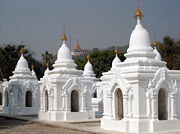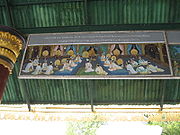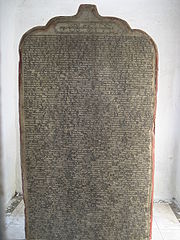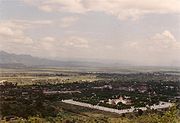
Kuthodaw Pagoda
Encyclopedia

Buddhism
Buddhism is a religion and philosophy encompassing a variety of traditions, beliefs and practices, largely based on teachings attributed to Siddhartha Gautama, commonly known as the Buddha . The Buddha lived and taught in the northeastern Indian subcontinent some time between the 6th and 4th...
stupa
Stupa
A stupa is a mound-like structure containing Buddhist relics, typically the remains of Buddha, used by Buddhists as a place of worship....
, located in Mandalay
Mandalay
Mandalay is the second-largest city and the last royal capital of Burma. Located north of Yangon on the east bank of the Irrawaddy River, the city has a population of one million, and is the capital of Mandalay Region ....
, Burma (Myanmar), that contains the world's largest book
World's largest book
The world's largest book stands upright, set in stone, in the grounds of the Kuthodaw pagoda at the foot of Mandalay Hill in Mandalay, Myanmar . It has 730 leaves and 1460 pages; each page is three and a half feet wide, five feet tall and five inches thick...
. It lies at the foot of Mandalay Hill
Mandalay Hill
Mandalay Hill is a 240 metre hill that is located to the northeast of the city centre of Mandalay in Burma. The city took its name from the hill. Mandalay Hill is known for its abundance of pagodas and monasteries, and has been a major pilgrimage site for Burmese Buddhists for nearly two centuries...
and was built during the reign of King Mindon
Mindon Min
Mindon Min was the penultimate king of Burma from 1853 to 1878. He was one of the most popular and revered kings of Burma. Under his half brother King Pagan, the Second Anglo-Burmese War in 1852 ended with the annexation of Lower Burma by the British Empire. Mindon and his younger brother Kanaung...
. The stupa itself, which is gilded above its terraces, is 188 feet (57.3 m) high, and is modelled after the Shwezigon Pagoda
Shwezigon Pagoda
The Shwezigon Pagoda or Shwezigon Paya is a Buddhist temple located in Nyaung-U, a town near Bagan, in Burma . It is a prototype of Burmese stupas, and consists of a circular gold leaf-gilded stupa surrounded by smaller temples and shrines...
at Nyaung-U
Nyaung-U
Nyaung-U is the administrative town of Nyaung-U Township of Nyaung-U District in the Mandalay Region of central Myanmar. It lies on the eastern bank of Ayeyarwaddy River. It is just 4 kilometers away from old Bagan, a popular tourist attraction. The Shwezigon Pagoda is located there...
near Bagan
Bagan
Bagan , formerly Pagan, is an ancient city in the Mandalay Region of Burma. Formally titled Arimaddanapura or Arimaddana and also known as Tambadipa or Tassadessa , it was the capital of several ancient kingdoms in Burma...
. In the grounds of the pagoda are 729 kyauksa gu or stone-inscription caves, each containing a marble slab inscribed on both sides with a page of text from the Tipitaka, the entire Pali Canon
Pāli Canon
The Pāli Canon is the standard collection of scriptures in the Theravada Buddhist tradition, as preserved in the Pāli language. It is the only completely surviving early Buddhist canon, and one of the first to be written down...
of Theravada Buddhism.
Royal merit


Mindon Min
Mindon Min was the penultimate king of Burma from 1853 to 1878. He was one of the most popular and revered kings of Burma. Under his half brother King Pagan, the Second Anglo-Burmese War in 1852 ended with the annexation of Lower Burma by the British Empire. Mindon and his younger brother Kanaung...
had the pagoda built as part of the traditional foundations of the new royal city of Mandalay in 1857. He was later to convene the Fifth Buddhist Synod
Fifth Buddhist council
The Fifth Buddhist council took place in Mandalay, Burma in 1871 AD in the reign of King Mindon. The chief objective of this meeting was to recite all the teachings of the Buddha according to the Theravada Pali Canon and examine them in minute detail to see if any of them had been altered,...
in 1871, but wanted to leave a great work of merit by having the Tipitaka set in stone for posterity, meant to last five millennia after the Buddha
Gautama Buddha
Siddhārtha Gautama was a spiritual teacher from the Indian subcontinent, on whose teachings Buddhism was founded. In most Buddhist traditions, he is regarded as the Supreme Buddha Siddhārtha Gautama (Sanskrit: सिद्धार्थ गौतम; Pali: Siddhattha Gotama) was a spiritual teacher from the Indian...
. Construction began in 1860, its hti
Hti
Hti is the name of the umbrella or top ornament found in almost all pagodas in Myanmar. They have been found in pagodas constructed by all four of the pagoda building ethnic groups of Myanmar: the Mon, the Bamar, the Rakhine and the Shan....
(umbrella or crown) mounted on 19 July 1862, and the inscriptions were laid open to the public on 4 May 1868. They were arranged in neat rows within three enclosures, 42 in the first, 168 in the middle and 519 in the third. One more stands at the southeast corner of the first enclosure making it 730, and this stone records how it all came into being. Thirty four brick zayat
Zayat
A zayat is a Burmese building found in almost every village. It serves primarily as a shelter for travelers, at the same time, is also an assembly place for religious occasions as well as meeting for the villagers to discuss the needs and plans of the village. Theravada buddhist monks use...
s (rest houses) stood all around except on the east side of the pagoda.

Deva (Hinduism)
' is the Sanskrit word for god or deity, its related feminine term is devi. In modern Hinduism, it can be loosely interpreted as any benevolent supernatural beings. The devs in Hinduism, also called Suras, are often juxtaposed to the Asuras, their half brothers. Devs are also the maintainers of...
. It is a covered approach or saungdan as in most Burmese pagodas with frescoes under the roof. Between the rows of stone-inscription stupas grow mature star flower trees (Mimusops elengi
Mimusops
Mimusops is a genus of plant in family Sapotaceae.Species include:* Mimusops acutifolia, Mildbr.* Mimusops angel, Chiov.* Mimusops commersonii* Mimusops caffra* Mimusops elengi...
) that emanate a jasmine-like fragrance to the entire complex. Burmese families may be seen having a picnic in the cool shade under these trees, picking the flowers to make star flower chains for the Buddha or to wear in their hair, or the children playing hide and seek among the rows of stupas. On the southwest inner terrace is one very old tree believed to be 250 years old, its low spreading boughs propped up by supports.
Annexation and desecration

Great Britain
Great Britain or Britain is an island situated to the northwest of Continental Europe. It is the ninth largest island in the world, and the largest European island, as well as the largest of the British Isles...
in 1885, the walled city with Mandalay Palace
Mandalay Palace
The Mandalay Palace , located in Mandalay, Myanmar, is the last royal palace of the last Burmese monarchy. The palace was constructed, between 1857 and 1859 as part of King Mindon's founding of new royal capital city of Mandalay. The plan of Mandalay Palace largely follows the traditional Burmese...
became Fort Dufferin, and troops were billeted all around Mandalay Hill in the monasteries, temples and pagodas. They became off-limits to the public and Burmese were no longer allowed to visit their religious sites. One revenue surveyor called U Aung Ban then came up with the idea of appealing direct to Queen Victoria since she had promised to respect all religions practised by her subjects. To their amazement and great joy the British queen promptly ordered the withdrawal of all her troops from religious precincts in 1890. This however turned to great sadness when they found that the pagoda had been looted from the hti, left lying on the ground stripped of its bells, gold, silver, diamonds, rubies and other precious stones, down to the Italian marble tiles from its terraces. The zayats lay in utter ruin and the bricks had been used to build a road for the troops. All the brass bells from all the kyauksa gu stupas were gone, 9 on each making it 6570 in total. The gold ink from the letters as well as the sides and top of each marble slab had also disappeared. All the biloo
Ogre
An ogre is a large, cruel, monstrous, and hideous humanoid monster, featured in mythology, folklore, and fiction. Ogres are often depicted in fairy tales and folklore as feeding on human beings, and have appeared in many classic works of literature...
s along the corridors had lost their heads, and the marble eyes and claws from the masonry chinthe
Chinthe
The Chinthe is a leogryph that is often seen at the entrances of pagodas and temples in Burma and other Southeast Asian countries. The chinthe is featured prominently on the kyat, the currency of Burma. The chinthe is almost always depicted in pairs, and serve to protect the pagoda...
s gone.
Restoration

Kinwon Min Gyi
Kinwon Min Gyi was a minister under King Mindon's and King Thibaw's reigns. He attempted to westernise the Burmese kingdom's existing bureaucracy into a more democratic system. Because of such attempts to do so, Kinwun Min Gyi was accused by many to have allowed Britain to win the Third...
U Kaung (chancellor), Hleithin Atwinwun (minister of the royal fleet), Yaunghwe Saopha
Saopha
Saopha, Chaofa, or Sawbwa was a royal title used by the rulers of the Shan States of Myanmar . The word means "king" in the Shan and Tai languages...
Sir Saw Maung and Mobyè Sitkè (a general of the royal army), was formed to start restoration works with the help and donations from the families of the original donors according to custom and also from the public in 1892.
It was the sitkè who asked permission from the senior monks to plant the hkayei star flower trees as well as some meze (Madhuca longifolia
Madhuca longifolia
Madhuca longifolia, commonly known as mahwa or mahua, is an Indian tropical tree found largely in the central and north Indian plains and forests. It is a fast-growing tree that grows to approximately 20 meters in height, possesses evergreen or semi-evergreen foliage, and belongs to the family...
) trees. Gold letters were replaced with black ink which made it easier to read. The metal htis of the kyauksa gus were replaced with stone paid for by members of the royal family (155), former officers of the royal army (58), Shan
Shan State
Shan State is a state of Burma . Shan State borders China to the north, Laos to the east, and Thailand to the south, and five administrative divisions of Burma in the west. Largest of the 14 administrative divisions by land area, Shan State covers 155,800 km², almost a quarter of the total...
Saophas and Myosas (102), and public donations (414). In 1913 Sir Po Tha, a rice trader of Rangoon, had the pagoda repaired and regilded. The next year, the Society of Pitaka Stone Inscriptions gave an iron gate to the south left open as the carved wooden panels had been destroyed by the soldiers. The west gate was donated by the famous zat mintha (theatre performer) U Po Sein the following year, and the north and east gates by the children and grandchildren of King Mindon in 1932. In 1919 the hermit U Khandi
U Khandi
U Khandi was a Burmese hermit known for his works on Buddhist pagodas and other religious buildings in Myanmar. U Khandi maintained the Mandalay Hill and organized many religious activities for 40 years. He was born Maung Po Maung in Ywathaya village, Yamethin District in 1868...
led the rebuilding of the south and west saungdans (covered approaches).
External links
- Asian Historical Architecture: Kuthodaw Temple (1857 and later) Prof. Robert D. Fiala, 2002, Concordia University, Nebraska, USA, Retrieved on 2006-08-27
- Mimusops elengi: star flower tree

